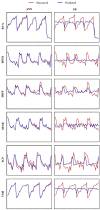Multilayer perceptron-genetic algorithm as a promising tool for modeling cultivation substrate of Auricularia cornea Native to Iran
- PMID: 36809254
- PMCID: PMC9942997
- DOI: 10.1371/journal.pone.0281982
Multilayer perceptron-genetic algorithm as a promising tool for modeling cultivation substrate of Auricularia cornea Native to Iran
Abstract
Auricularia cornea Ehrenb (syn. A. polytricha) is a wood-decaying fungi known as black ear mushroom. Earlike gelatinous fruiting body distinguishes them from other fungi. Industrial wastes have the potential to be used as the basic substrate to produce mushrooms. Therefore, 16 substrate formulations were prepared from different ratios of beech (BS) and hornbeam sawdust (HS) supplemented with wheat (WB) and rice brans (RB). The pH and initial moisture content of substrate mixtures were adjusted to 6.5 and 70%, respectively. The comparison of in vitro growth characteristics of the fungal mycelia under the different temperatures (25, 28, and 30°C), and culture media [yeast extract agar (YEA), potato extract agar (PEA), malt extract agar (MEA), and also HS and BS extract agar media supplemented with maltose, dextrose, and fructose revealed that the highest mycelial growth rate (MGR; 7.5 mm/day) belonged to HS and BS extract agar media supplemented with three mentioned sugar at 28°C. In A. cornea spawn study, the substrate combination of BS (70%) + WB (30%) at 28°C and moisture contents of 75% displayed the highest mean MGR (9.3 mm/day) and lowest spawn run period (9.0 days). In the bag test, "BS (70%) + WB (30%)" was the best substrate displaying the shortest spawn run period (19.7 days), and the highest fresh sporophore yield (131.7 g/bag), biological efficiency (53.1%) and number of basidiocarp (9.0/bag) of A. cornea. Also, A. cornea cultivation was processed to model yield, biological efficiency (BE), spawn run period (SRP), days for pinhead formation (DPHF), days for the first harvest (DFFH), and total cultivation period (TCP) by multilayer perceptron-genetic algorithm (MLP-GA). MLP-GA (0.81-0.99) exhibited a higher predictive ability than stepwise regression (0.06-0.58). The forecasted values of the output variables were in good accordance with their observed ones corroborating the good competency of established MLP-GA models. MLP-GA modeling exhibited a powerful tool for forecasting and thus selecting the optimal substrate for maximum A. cornea production.
Copyright: © 2023 Jahedi et al. This is an open access article distributed under the terms of the Creative Commons Attribution License, which permits unrestricted use, distribution, and reproduction in any medium, provided the original author and source are credited.
Conflict of interest statement
The authors have declared that no competing interests exist.
Figures




Similar articles
-
Lentinula edodes substrate formulation using multilayer perceptron-genetic algorithm: a critical production checkpoint.Front Microbiol. 2024 May 21;15:1366264. doi: 10.3389/fmicb.2024.1366264. eCollection 2024. Front Microbiol. 2024. PMID: 38841070 Free PMC article.
-
Effect of Different Culture Media, Grain Sources and Alternate Substrates on the Mycelial Growth of Pleurotus eryngii and Pleurotus ostreatus.Pak J Biol Sci. 2020 Jan;23(3):223-230. doi: 10.3923/pjbs.2020.223.230. Pak J Biol Sci. 2020. PMID: 31944082
-
Comparative study of mycelia growth and sporophore yield of Auricularia polytricha (Mont.) Sacc on selected palm oil wastes as fruiting substrate.Appl Microbiol Biotechnol. 2013 Apr;97(7):3207-13. doi: 10.1007/s00253-012-4135-8. Epub 2012 May 12. Appl Microbiol Biotechnol. 2013. PMID: 22576946
-
Isolation and Characterization of Airborne Mushroom Damaging Trichoderma spp. from Indoor Air of Cultivation Houses Used for Oak Wood Mushroom Production Using Sawdust Media.Plant Pathol J. 2019 Dec;35(6):674-683. doi: 10.5423/PPJ.FT.10.2019.0261. Epub 2019 Dec 12. Plant Pathol J. 2019. PMID: 31832047 Free PMC article. Review.
-
Cultivation Technologies for Production of Medicinal Mushroom Biomass: Review.Int J Med Mushrooms. 2022;24(2):1-22. doi: 10.1615/IntJMedMushrooms.2021042445. Int J Med Mushrooms. 2022. PMID: 35446518 Review.
Cited by
-
Culture-based diversity of endophytic fungi of three species of Ferula grown in Iran.Front Microbiol. 2024 May 23;15:1363158. doi: 10.3389/fmicb.2024.1363158. eCollection 2024. Front Microbiol. 2024. PMID: 38846573 Free PMC article.
-
Lentinula edodes substrate formulation using multilayer perceptron-genetic algorithm: a critical production checkpoint.Front Microbiol. 2024 May 21;15:1366264. doi: 10.3389/fmicb.2024.1366264. eCollection 2024. Front Microbiol. 2024. PMID: 38841070 Free PMC article.
-
Gaining insights into epigenetic memories through artificial intelligence and omics science in plants.J Integr Plant Biol. 2025 Sep;67(9):2320-2349. doi: 10.1111/jipb.13953. Epub 2025 Jun 24. J Integr Plant Biol. 2025. PMID: 40552708 Free PMC article. Review.
References
-
- Abraham L, Hoffman B, Gao Y, Breuil C. Action of Ophiostoma piceae proteinase and lipase on wood nutrients. Can. J. Microbiol. 1998; 44(7): 698–701. doi: 10.1139/w98-046 - DOI
-
- Kirk PM, Cannon PF, David JC, Stalpers JA. Ainsworth & Bisby’s Dictionary of the Fungi. CAB International, Wallingford, UK. 2001. doi: 10.1079/9780851998268.0000 - DOI
-
- Well K. The Jelly fungi, then and now. Mycologia. 1984; 86:18–48. doi: 10.1080/00275514.1994.12026372 - DOI
-
- Zoberi HM. Tropical Macrofungi: some common species. Macmillan, London, UK. 1972.
-
- Singh M, Kamal S, Sharma VP. Status and trends in world mushroom production-III: World Production of Different Mushroom Species in 21st Century. Mushroom Res. 2020; 29(2): 75–111. doi: 10.36036/MR.29.2.2020.113703 - DOI
MeSH terms
Substances
Supplementary concepts
LinkOut - more resources
Full Text Sources
Miscellaneous

